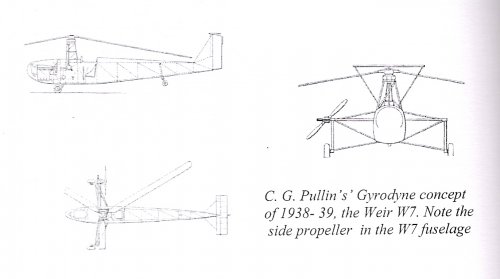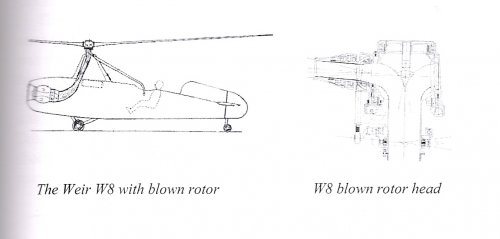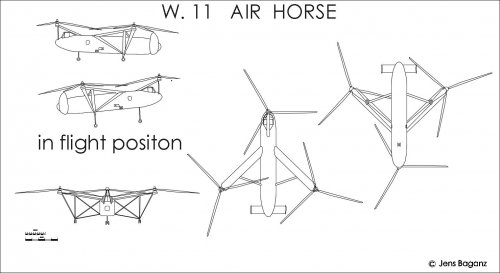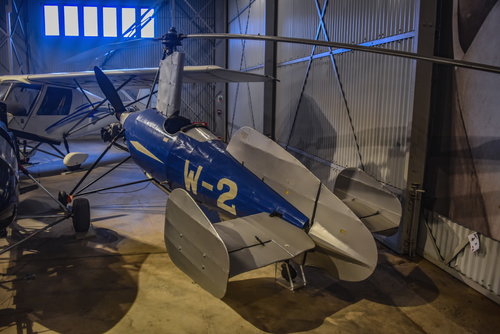- Joined
- 25 July 2007
- Messages
- 4,167
- Reaction score
- 3,834
Cy-27 said that he was working on a Weir designation list which which was the kick in the pants needed to prompt me to finish off my list!
____________________
J&G Weir Company, 1932-1943, and Cierva Autogiro Company (Cierva-Weir), 1943-1951
Weir autogyros and helicopters received simple, sequential 'W' designations. Contemporary sources show 'W.x", 'W-x', and 'W x' styles. For consistancy, I've stuck with hyphens.
For a short history of Weir autogiros/helicopters, see Scottish contributions to rotary wing flight by D. Cameron and DG Thomson, AHS 64th Annual Forum, April 29th-May 1st, 2008. http://eprints.gla.ac.uk/4973/1/4973.pdf
_________________________
Weir Aircraft Designations
Weir W-1 - May 1933 autogyro, 1 x 40 hp Douglas Dryad HO-2 engine
- Weir W-1: First successful two-bladed rotor, 8.53 m diameter
-- Weir W-2 aka Cierva C 28 (built under license from Cierva)
Weir W-2 - March 1934 'jump start' autogyro, 1 x 50 hp Weir O-92*
- W-2: 'Cleaned up' W-1, modified 8.53 m diameter W-1 rotor
-- * Some sources apply 'Dryad II' name to the Weir O-92
-- Weir W-2 serial production planned but not realized**
-- ** Some stability problems, fitted with W-3 tail surfaces
-- http://1000aircraftphotos.com/Contributions/9914.htm
Weir W-3 - 1936 experimental single-seat 'direct take-off'* autogyro
- W-3: 1 x 50 hp Weir Pixie I inv'd 4-cyl inline, 5.66 m rotor diameter
-- * clutched 2-bladed 'Auto-dynamic'rotor for VTOL (Cierva concept)
-- http://www.flightglobal.com/pdfarchive/view/1953/1953 - 0098.html
-- http://www.aviastar.org/helicopters_eng/weir_w3.php
Weir W-4 - 1937 Refined W-3, 68 hp Weir Pixie II inverted 4-cyl inline
- W-4: Endplate tail surfaces similar to final W-2 config.
-- W-4 destroyed in early tests (rolled on side during 'jump start')
- W-4: [Project] co-axial rotors helicopter conv., led to W-5
Weir W-5 -- 1938 single-seat helicopter, 4.57m rotor diameter
- W-5: [Project] Coaxial rotors W-4 autogyro conversion
- W-5: 1 x fan-cooled 50 hp Weir Pixie II, side-by-side rotors*
-- * Plywood box beams support the twin lateral 2-bladed rotors
-- W-5 design infl. by Cierva-licensed Focke-Achgelis Fa 61
-- http://www.aviastar.org/helicopters_eng/weir_w5.php
Weir W-6 - 1939, enlarged 2-seat devel. of W-5 helicopter*
- W-6: 1 x fan-cooled 200 hp DH Gipsy Six II, 7.93 m rotor diameter
-- * W-6 used twin 3-bladed rotors, welded steel tube outriggers
-- http://www.aviastar.org/helicopters_eng/weir_w6.php
NB: Weir W-5 and W-6 rotor thrust controlled by rotor speed
W-7 - [Project] 1940 3-seat helicopter, 3-blade main rotor, nose engine
- W-7: Offset torque-countering rotor mounted to starboard u/c struts
-- W-7 aka Weir Gyrodyne (combining features of helicopter and autogyro)
-- W-7 offered to the Royal Navy as a 'Fleet Shadower' ASW a/c
Weir W-8 - [Project] single-seat, single-rotor experimental helicopter
- W-8: Blown rotor through rotor head, see Reply #2
1943 - G & J Weir Ltd. aeronautical department reconstituted as Cierva Autogiro Company (aka Cierva-Weir). These may be described as 'Ciervas' but 'W' designations remain.
Weir W-9 - 1944 2-seat single-rotor helo, fan thrust countered rotor torque
- W-9: 1 x 200 hp DH Gipsy Six II,* 10.97 m main rotor diameter
-- * Some sources say powered by 1 x 205 hp DH Gipsy Queen 31
-- W-9: Prompted by Sikorsky R-4/R-5, first flown 1946
Weir W-10 (I) - (Project) See reply #11, tri-rotor helicopter
- W-10: 2 x Armstrong-Siddeley Cheetah radials, 3 x rotors
- W-10: Abandoned in favour of W-11, desig. re-allocated
Weir W-10 (II) - (Project) 1946 single-rotor helicopter
- W-10: 4-to-6-seat helicopter, similar in layout to W-9
- W-10: 1 x 510 hp Armstrong-Siddeley Cheetah, 14 m rotor diameter
Weir W-11 - Air-Horse, 3-rotor helicopter designed for crop dusting
- W-11 : To AM Spec. E19/46, Air-Horse aka 'Spraying Mantis'
- W-11 : As conceived (mock-up), 2 x rotors forward + 1 x aft
- W-11 : Post wind tunnel tests, 1 x rotor forward + 2 x aft
-- W-11: 1 x 1,620 hp Rolls-Royce Merlin 24,* 14.32 m rotor diameter
-- * Orig. intention to power with Merlin 32?, see reply #11
- W-11 : As flown, 1950, crashed on flight tests, development terminated
- W-11T: (Project) 1949 twin-engined W.11 deriv., 2 x RR Merlin 502**
-- ** Merlin 502s mounted on stub wings to facilitate re-engining
-- ** Alt. turboshafts envisioned or auxiliary propellers on stub wings
-- https://www.flightglobal.com/pdfarchive/view/1946/1946 - 1288.html
Weir W-12 (I) - (Project) See reply #11, tri-rotor helicopter
- W-12 (I): Revamped version of the first Weir W-10 project
Weir W-12 (II) - (Project) Reduced-scale W.11 devel., 2 variants
- W-12 (II) : 2 x (??) shp Rolls-Royce Dart turbines
- W-12 (II) : Passenger vers., 12 pax (half that of W-11 Air-Horse)
- W-12A (II): Freighter vers., clamshell rear doors, 1.5 ton payload
Weir W-13 - [not assigned]
Weir W-14 - Skeeter 1948 2-seat experimental helicopter, x 1
- W-14: Prototype for Saro Skeeter military training helicopter
-- Deve. taken over by reformed Cierva company, 2 x prototypes
-- W-14 Skeeter I : 1 x 110 hp Jameson FF-1 HO-4, x 1 (G-AJCJ)
-- W-14 Skeeter II: 1 x 145 hp DH Gipsy Major X, x 1 (G-ALUF)
___________________________
____________________
J&G Weir Company, 1932-1943, and Cierva Autogiro Company (Cierva-Weir), 1943-1951
Weir autogyros and helicopters received simple, sequential 'W' designations. Contemporary sources show 'W.x", 'W-x', and 'W x' styles. For consistancy, I've stuck with hyphens.
For a short history of Weir autogiros/helicopters, see Scottish contributions to rotary wing flight by D. Cameron and DG Thomson, AHS 64th Annual Forum, April 29th-May 1st, 2008. http://eprints.gla.ac.uk/4973/1/4973.pdf
_________________________
Weir Aircraft Designations
Weir W-1 - May 1933 autogyro, 1 x 40 hp Douglas Dryad HO-2 engine
- Weir W-1: First successful two-bladed rotor, 8.53 m diameter
-- Weir W-2 aka Cierva C 28 (built under license from Cierva)
Weir W-2 - March 1934 'jump start' autogyro, 1 x 50 hp Weir O-92*
- W-2: 'Cleaned up' W-1, modified 8.53 m diameter W-1 rotor
-- * Some sources apply 'Dryad II' name to the Weir O-92
-- Weir W-2 serial production planned but not realized**
-- ** Some stability problems, fitted with W-3 tail surfaces
-- http://1000aircraftphotos.com/Contributions/9914.htm
Weir W-3 - 1936 experimental single-seat 'direct take-off'* autogyro
- W-3: 1 x 50 hp Weir Pixie I inv'd 4-cyl inline, 5.66 m rotor diameter
-- * clutched 2-bladed 'Auto-dynamic'rotor for VTOL (Cierva concept)
-- http://www.flightglobal.com/pdfarchive/view/1953/1953 - 0098.html
-- http://www.aviastar.org/helicopters_eng/weir_w3.php
Weir W-4 - 1937 Refined W-3, 68 hp Weir Pixie II inverted 4-cyl inline
- W-4: Endplate tail surfaces similar to final W-2 config.
-- W-4 destroyed in early tests (rolled on side during 'jump start')
- W-4: [Project] co-axial rotors helicopter conv., led to W-5
Weir W-5 -- 1938 single-seat helicopter, 4.57m rotor diameter
- W-5: [Project] Coaxial rotors W-4 autogyro conversion
- W-5: 1 x fan-cooled 50 hp Weir Pixie II, side-by-side rotors*
-- * Plywood box beams support the twin lateral 2-bladed rotors
-- W-5 design infl. by Cierva-licensed Focke-Achgelis Fa 61
-- http://www.aviastar.org/helicopters_eng/weir_w5.php
Weir W-6 - 1939, enlarged 2-seat devel. of W-5 helicopter*
- W-6: 1 x fan-cooled 200 hp DH Gipsy Six II, 7.93 m rotor diameter
-- * W-6 used twin 3-bladed rotors, welded steel tube outriggers
-- http://www.aviastar.org/helicopters_eng/weir_w6.php
NB: Weir W-5 and W-6 rotor thrust controlled by rotor speed
W-7 - [Project] 1940 3-seat helicopter, 3-blade main rotor, nose engine
- W-7: Offset torque-countering rotor mounted to starboard u/c struts
-- W-7 aka Weir Gyrodyne (combining features of helicopter and autogyro)
-- W-7 offered to the Royal Navy as a 'Fleet Shadower' ASW a/c
Weir W-8 - [Project] single-seat, single-rotor experimental helicopter
- W-8: Blown rotor through rotor head, see Reply #2
1943 - G & J Weir Ltd. aeronautical department reconstituted as Cierva Autogiro Company (aka Cierva-Weir). These may be described as 'Ciervas' but 'W' designations remain.
Weir W-9 - 1944 2-seat single-rotor helo, fan thrust countered rotor torque
- W-9: 1 x 200 hp DH Gipsy Six II,* 10.97 m main rotor diameter
-- * Some sources say powered by 1 x 205 hp DH Gipsy Queen 31
-- W-9: Prompted by Sikorsky R-4/R-5, first flown 1946
Weir W-10 (I) - (Project) See reply #11, tri-rotor helicopter
- W-10: 2 x Armstrong-Siddeley Cheetah radials, 3 x rotors
- W-10: Abandoned in favour of W-11, desig. re-allocated
Weir W-10 (II) - (Project) 1946 single-rotor helicopter
- W-10: 4-to-6-seat helicopter, similar in layout to W-9
- W-10: 1 x 510 hp Armstrong-Siddeley Cheetah, 14 m rotor diameter
Weir W-11 - Air-Horse, 3-rotor helicopter designed for crop dusting
- W-11 : To AM Spec. E19/46, Air-Horse aka 'Spraying Mantis'
- W-11 : As conceived (mock-up), 2 x rotors forward + 1 x aft
- W-11 : Post wind tunnel tests, 1 x rotor forward + 2 x aft
-- W-11: 1 x 1,620 hp Rolls-Royce Merlin 24,* 14.32 m rotor diameter
-- * Orig. intention to power with Merlin 32?, see reply #11
- W-11 : As flown, 1950, crashed on flight tests, development terminated
- W-11T: (Project) 1949 twin-engined W.11 deriv., 2 x RR Merlin 502**
-- ** Merlin 502s mounted on stub wings to facilitate re-engining
-- ** Alt. turboshafts envisioned or auxiliary propellers on stub wings
-- https://www.flightglobal.com/pdfarchive/view/1946/1946 - 1288.html
Weir W-12 (I) - (Project) See reply #11, tri-rotor helicopter
- W-12 (I): Revamped version of the first Weir W-10 project
Weir W-12 (II) - (Project) Reduced-scale W.11 devel., 2 variants
- W-12 (II) : 2 x (??) shp Rolls-Royce Dart turbines
- W-12 (II) : Passenger vers., 12 pax (half that of W-11 Air-Horse)
- W-12A (II): Freighter vers., clamshell rear doors, 1.5 ton payload
Weir W-13 - [not assigned]
Weir W-14 - Skeeter 1948 2-seat experimental helicopter, x 1
- W-14: Prototype for Saro Skeeter military training helicopter
-- Deve. taken over by reformed Cierva company, 2 x prototypes
-- W-14 Skeeter I : 1 x 110 hp Jameson FF-1 HO-4, x 1 (G-AJCJ)
-- W-14 Skeeter II: 1 x 145 hp DH Gipsy Major X, x 1 (G-ALUF)
___________________________
Last edited:




